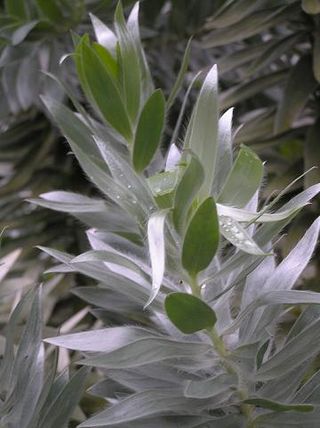
Leucadendron is a genus of about 80 species of flowering plants in the family Proteaceae, endemic to the Cape Provinces and KwaZulu-Natal in South Africa, where they are a prominent part of the fynbos ecoregion and vegetation type.

Protea laurifolia, also known as the grey-leaf sugarbush, is a shrub from South Africa. It is native to the Cape Provinces of South Africa.

Leucadendron strobilinum, commonly called the peninsula conebush, is a plant species in the genus Leucadendron—forming part of the family Proteaceae. Confined to the Cape Peninsula of South Africa, it reaches a height of up to 2.6 metres growing in southern, damp rocky slopes at an elevation of 500 to 1100m. Its conservation status is Near Threatened—a result of inappropriate fire management, fire-break clearing and alien plant invasions.
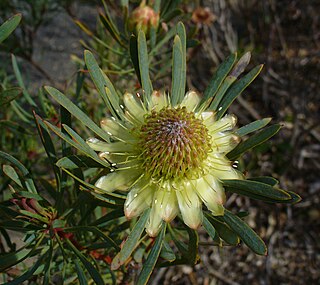
Protea scolymocephala, also known as the thistle protea or thistle sugarbush, is a flowering plant from the genus Protea native to South Africa.

Leucadendron microcephalum, common name oilbract conebrush, is a dioecious, single-stemmed, South African shrub belonging to the family Proteaceae, endemic to the Western Cape and growing from sea level to 1,200 m (3,900 ft). It is one of some 200 species in the genus, all confined to South Africa.
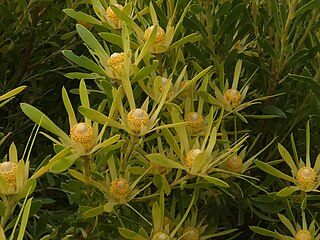
Leucadendron coniferum, also known at the dune conebush, is an evergreen, dioecious shrub or small tree of up to 4 m (13 ft) high, that has been assigned to the family Proteaceae. It has a whorl of conspicuous yellow leaves subtending the flowerheads. The flowers can be found in August and September. It grows in sandy soils near the coast of the Western Cape province of South Africa.
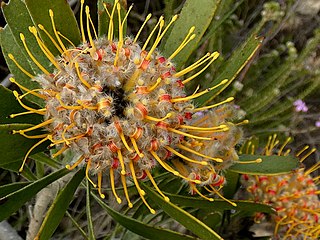
Leucospermum truncatum, commonly known as the limestone pincushion, is a shrub native to South Africa. The flowers are initially bright yellow but turn orange with time. Flowers can be found between August and December.

Vexatorella obtusata is an evergreen shrub, with narrow, leathery leaves and about 2 cm big, globular flowerheads consisting of well scented, creamy pink flowers, from which a long style with a thickened tip extends. Two subspecies are distinguished, both restricted to different parts of the Western Cape province of South Africa. The creeping V. obtusata subsp. obtusata, also known as the Montagu vexator flowers from September to December, and the upright V. obtusata subsp. albomontana, also known as the Witteberg vexator, that has flowers between August and November.
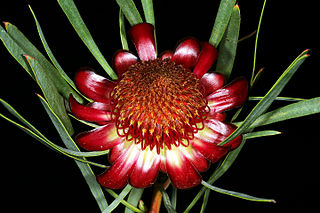
Protea acuminata, also known in English as the black-rim sugarbush, or in the Afrikaans language as sederbergsuikerbos, is a flowering shrub belonging to the genus Protea. The plant is endemic to South Africa. There are isolated populations at Nieuwoudtville, and in the Cederberg, Stettynskloof and Riviersonderend Mountains. It can grow as an upright tree. It can become up to two metres in height. It blooms from June to September, with the peak of July to August. Periodic wildfires may destroy the adult plants, but the seeds can survive such an event. The seeds are dispersed by means of the wind. The plant is monoecious with both sexes in each flower. It is unknown what causes the pollination to occur. The plant grows in sandy plains and coastal lowlands from sea-level to altitudes of 400 metres. It is a widespread species which is not in danger, and the conservation status has been assessed as 'least concern'.
Leucadendron ericifolium, the erica-leaved conebush, is a flower-bearing shrub that belongs to the genus Leucadendron and forms part of the fynbos. The plant is native to the Western Cape, South Africa.

Leucadendron daphnoides, the Du Toit's Kloof conebush, is a flower-bearing shrub in the genus Leucadendron and forms part of the fynbos. The plant is native to the Western Cape and occurs in the Slanghoek, Du Toits, and Stettynskloof mountains. The shrub grows up to 1.5 m tall and flowers from July to September.
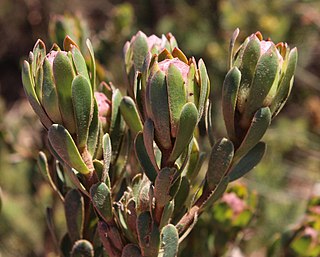
Leucadendron stelligerum, the Agulhas conebush, is a flower-bearing shrub that belongs to the genus Leucadendron and forms part of the fynbos. The plant is native to the Western Cape where it occurs from Elim to the Agulhas Plain.
Leucadendron cryptocephalum, the concealed conebush, is a flower-bearing shrub that belongs to the genus Leucadendron and forms part of the fynbos. The plant is native to the Western Cape and only two populations occur at Potberg and the Groenlandberg. There is little information available about the plant.
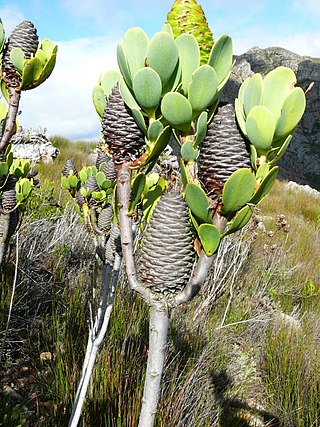
Leucadendron immoderatum, the lollipop conebush, is a flower-bearing shrub belonging to the genus Leucadendron and forms part of the fynbos. The plant is native to the Western Cape where it occurs at Riviersonderend.

Leucadendron brunioides var. brunioides, the common foetid conebush, is a flower-bearing shrub and variety of Leucadendron brunioides, which belongs to the genus Leucadendron and forms part of the fynbos. The plant is native to the Western Cape where it occurs on the Bokkeveld Carp near Nieuwoudtville, the Sandveld, Gifberg, Cederberg to the eastern Koue Bokkeveld, Hex River Mountains, and the Breede River Valley.
Leucadendron sheilae, the Lokenberg conebush, is a flower-bearing shrub that belongs to the genus Leucadendron and forms part of the fynbos, a South African biogeographical region. The plant is native to the Western and Northern Capes, where it occurs at Lokenberg in the Bokkeveld Mountains. The plant grows mainly in hard sandstone sand on level crests at altitudes of 600 to 900 metres (2,000–3,000 ft). In Afrikaans it is known as Lokenberg-tolbos.
Leucadendron meyerianum, the Van Rhynsdorp conebush, is a flower-bearing shrub that belongs to the family Proteaceae. It is part of the fynbos vegetation type of South Africa. The plant is native to the Western Cape and Northern Cape, where it occurs in the Bokkeveld escarpment near Nieuwoudtville. The shrub grows 2.0 m tall and bears flowers in August. Two months after the plant has flowered, the fruit appears and the seeds later fall to the ground where they are spread by rodents. The plant grows in level, sandstone sand at altitudes of 800 m. Small beetles do the pollination.
Leucadendron radiatum, also called the Langeberg conebush, is a flowering shrub that belongs to the family Proteaceae. It is part of the South African Fynbos vegetation type. The plant is endemic to the Western Cape where it occurs on the Langeberg from Grootberg to Kampscheberg.
Leucadendron roodii, the Gifberg conebush, is a flowering shrub that belongs to the genus Leucadendron and forms part of the fynbos biome. The plant is endemic to the Western Cape province of South Africa, where it occurs on the Gifberg mountain.
Leucadendron galpinii, the hairless conebush, is a flowering shrub in the family Proteaceae that is native to Africa.













